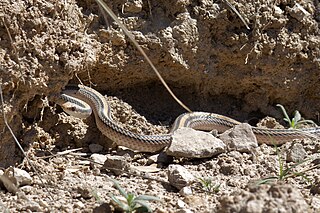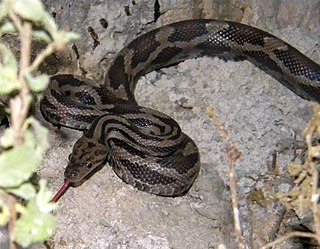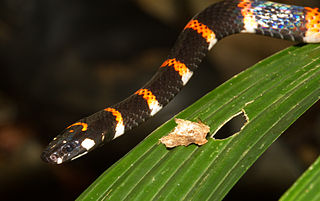
Kingsnakes are colubrid New World members of the genus Lampropeltis, which includes 26 species. Among these, about 45 subspecies are recognized. They are nonvenomous and ophiophagous in diet.

The royal ground snake is a species of snake in the family Colubridae. The species is endemic to northern South America.

Hypsiglena is a genus of small, rear-fanged snakes, commonly referred to as night snakes, in the subfamily Dipsadinae of the family Colubridae. The genus consists of nine species. Three of these species have subspecies, which have been maintained pending further investigation.

Salvadora is a genus of colubrid snakes commonly called patchnose snakes or patch-nosed snakes, which are endemic to the western United States and Mexico. They are characterized by having a distinctive scale on the tip of the snout.

Cemophora coccinea, commonly known as the scarlet snake, is a species of nonvenomous snake in the family Colubridae. The species is native to the southeastern United States. There are two subspecies of C. coccinea that are recognized as being valid. The Texas scarlet snake was previously considered a subspecies.
Hypsiglena torquata, the night snake, is a species of rear-fanged colubrid. It is found in Mexico.

The Texas spotted whiptail is a species of long-tailed lizard, in the family Teiidae. The species is endemic to the south central and southwestern United States and northern Mexico. Six subspecies are recognized as being valid.

Hypsiglena jani, commonly known as the Texas night snake or the Chihuahuan night snake, is a small species of mildly venomous snake in the family Colubridae. The species is native to the southwestern United States and adjacent northeastern Mexico.

The California night snake is a subspecies of small colubrid snake native to California.

Salvadora hexalepis, the western patch-nosed snake, is a species of non-venomous colubrid snake, which is endemic to the southwestern United States and northern Mexico.

The California mountain kingsnake is a species of nonvenomous colubrid snake that is endemic to North America. It is a coral snake mimic, having a similar pattern consisting of red, black, and yellow on its body, but the snake is completely harmless. Seven subspecies are recognized, with five found in the U.S., including the nominotypical subspecies, and two in Mexico.

Thamnophis proximus, commonly known as the western ribbon snake or western ribbonsnake, is a species of garter snake in the subfamily Natricinae of the family Colubridae. The species is found in the central and southern United States, Mexico, and Central America south to central Costa Rica. The species has six recognized subspecies.

Senticolis is a genus of nonvenomous snake in the family Colubridae. The genus Senticolis is monotypic, containing the sole species Senticolis triaspis, also known as the green rat snake. The species is endemic to Central America, Mexico, southern Arizona, and southern New Mexico.
Amastridium is a genus of snakes in the subfamily Dipsadinae of the family Colubridae. The genus is native to Mexico, Central America and Colombia.

Micruroides is a genus of venomous coral snake in the family Elapidae. The genus is monotypic, containing only the species Micruroides euryxanthus.
The West Coast garter snake is a species of snake in the family Colubridae. The species is endemic to Mexico. Four subspecies are recognized.

The yellow-red rat snake is a species of snake in the family Colubridae. The species is endemic to Mexico and Central America. Three subspecies are recognized.

Pliocercus euryzonus, commonly known as Cope's false coral snake, is a species of snake in the subfamily Dipsadinae of the family Colubridae. The species is indigenous to southeastern Central America and northwestern South America. There are two recognized subspecies.

Ialtris is a genus of snakes in the subfamily Dipsadinae of the family Colubridae. The genus is endemic to the island of Hispaniola.
Pliocercus elapoides, also known commonly as the variegated false coral snake, is a species of snake in the family Colubridae. The species is native to southern North America and northern Central America. There are four recognized subspecies.
















